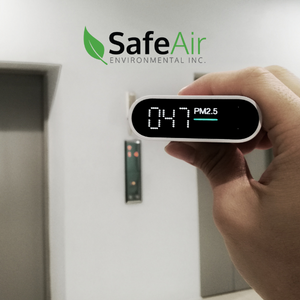Indoor Air Quality Testing Parameters, Explained
Posted in Air Quality, on October 08, 2021
 In the aftermath of the covid-19 pandemic, the safety of our indoor air environments is a significant concern. Indoor air quality testing for Toronto workplaces and community buildings like schools is at the top of the agenda for many managers and administrators looking to improve their ventilation, reduce pollutants, and measure the health and safety of their buildings. At SafeAir, our air quality testing parameters can help you accurately gauge your risk and make positive changes to improve your environment.
In the aftermath of the covid-19 pandemic, the safety of our indoor air environments is a significant concern. Indoor air quality testing for Toronto workplaces and community buildings like schools is at the top of the agenda for many managers and administrators looking to improve their ventilation, reduce pollutants, and measure the health and safety of their buildings. At SafeAir, our air quality testing parameters can help you accurately gauge your risk and make positive changes to improve your environment.
The Major Air Quality Pollutants
There are a handful of major indoor air quality pollutants that can circulate in buildings. Many of these pollutants are exacerbated or caused by air quality issues such as:
- Poor ventilation
- High indoor humidity
- Scented cleaning products
- Environmental factors
- Age or design-related problems
The five major pollutants that we find during air quality testing include:
- Mold spores
- Radon gas
- Volatile Organic Compounds (VOCs)
- Particulate matter (dust, construction materials, car exhaust)
- Carbon monoxide
Key Air Quality Parameters
What makes good air quality? SafeAir’s indoor air quality testing parameters are guided by leading industry researchers and through consulting local building codes and best practices. Some of the conditions that the government of Canada cites include:
- Carbon Dioxide levels over a 24 hour period must be less than 100ppm.
- Carbon Monoxide levels over a 24 hour period must be less than 10ppm.
- Formaldehyde levels must be less than 100 ppb (1 hour or less exposure) or 40 ppb for exposure times 8 hours or longer.
- Humidity should be between 30-50%
- Temperature should be between 23-26℃
- Radon gas should be below 200 BQ/M
How is Air Quality Measured
The only way to know if your home or workplace is testing within allowable limits for indoor air quality pollutants is to have a professional indoor air quality test with a company like SafeAir. We’ll visit your home and take multiple readings (often indoors and out), and test for all of the common indoor air quality pollutants. Our comprehensive visual inspection will identify areas that may be causing or worsening air quality problems. All of our tests are sent to a third-party lab to provide impartial, unbiased results, and once we know what issues are present, we’ll help you find solutions to solve them and make a positive change.
SafeAir can also provide long-term testing or monitoring. One pollutant that requires long-term testing is radon gas, which can fluctuate with the weather or seasons. Radon testing usually happens over a 3-6 month time period using a passive monitoring device.
Indoor Air Quality Improvements
It’s not hard to improve your indoor air quality — in fact, most of the solutions we suggest at SafeAir range between $0-150. Corrections to your indoor air quality have many positive health effects and can improve overall health and sleep, concentration, and more. To book indoor air quality testing with SafeAir, use our contact page to reach out to our team.

